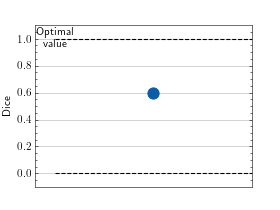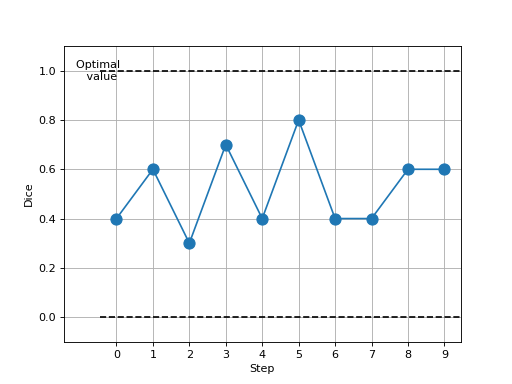Dice¶
Module Interface¶
- class torchmetrics.Dice(zero_division=0, num_classes=None, threshold=0.5, average='micro', mdmc_average='global', ignore_index=None, top_k=None, multiclass=None, **kwargs)[source]¶
Compute Dice.
\[\text{Dice} = \frac{\text{2 * TP}}{\text{2 * TP} + \text{FP} + \text{FN}}\]Where \(\text{TP}\) and \(\text{FP}\) represent the number of true positives and false positives respecitively.
It is recommend set ignore_index to index of background class.
The reduction method (how the precision scores are aggregated) is controlled by the
averageparameter, and additionally by themdmc_averageparameter in the multi-dimensional multi-class case.As input to
forwardandupdatethe metric accepts the following input:preds(Tensor): Predictions from model (probabilities, logits or labels)target(Tensor): Ground truth values
As output to
forwardandcomputethe metric returns the following output:dice(Tensor): A tensor containing the dice score.If
average in ['micro', 'macro', 'weighted', 'samples'], a one-element tensor will be returnedIf
average in ['none', None], the shape will be(C,), whereCstands for the number of classes
- Parameters:
num_classes¶ – Number of classes. Necessary for
'macro', andNoneaverage methods.threshold¶ – Threshold for transforming probability or logit predictions to binary (0,1) predictions, in the case of binary or multi-label inputs. Default value of 0.5 corresponds to input being probabilities.
zero_division¶ – The value to use for the score if denominator equals zero.
average¶ –
Defines the reduction that is applied. Should be one of the following:
'micro'[default]: Calculate the metric globally, across all samples and classes.'macro': Calculate the metric for each class separately, and average the metrics across classes (with equal weights for each class).'weighted': Calculate the metric for each class separately, and average the metrics across classes, weighting each class by its support (tp + fn).'none'orNone: Calculate the metric for each class separately, and return the metric for every class.'samples': Calculate the metric for each sample, and average the metrics across samples (with equal weights for each sample).
Hint
What is considered a sample in the multi-dimensional multi-class case depends on the value of
mdmc_average.mdmc_average¶ –
Defines how averaging is done for multi-dimensional multi-class inputs (on top of the
averageparameter). Should be one of the following:None[default]: Should be left unchanged if your data is not multi-dimensional multi-class.'samplewise': In this case, the statistics are computed separately for each sample on theNaxis, and then averaged over samples. The computation for each sample is done by treating the flattened extra axes...as theNdimension within the sample, and computing the metric for the sample based on that.'global': In this case theNand...dimensions of the inputs are flattened into a newN_Xsample axis, i.e. the inputs are treated as if they were(N_X, C). From here on theaverageparameter applies as usual.
ignore_index¶ – Integer specifying a target class to ignore. If given, this class index does not contribute to the returned score, regardless of reduction method. If an index is ignored, and
average=Noneor'none', the score for the ignored class will be returned asnan.top_k¶ – Number of the highest probability or logit score predictions considered finding the correct label, relevant only for (multi-dimensional) multi-class inputs. The default value (
None) will be interpreted as 1 for these inputs. Should be left at default (None) for all other types of inputs.multiclass¶ – Used only in certain special cases, where you want to treat inputs as a different type than what they appear to be.
kwargs¶ – Additional keyword arguments, see Advanced metric settings for more info.
Warning
The
dicemetrics is being deprecated from the classification subpackage in v1.6.0 of torchmetrics and will be removed in v1.7.0. Please instead consider usingf1scoremetric from the classification subpackage as it provides the same functionality. Additionally, we are going to re-add thedicemetric in the segmentation domain in v1.6.0 with slight modifications to functionality.- Raises:
ValueError – If
averageis none of"micro","macro","samples","none",None.ValueError – If
mdmc_averageis not one ofNone,"samplewise","global".ValueError – If
averageis set butnum_classesis not provided.ValueError – If
num_classesis set andignore_indexis not in the range[0, num_classes).
Example
>>> from torch import tensor >>> from torchmetrics.classification import Dice >>> preds = tensor([2, 0, 2, 1]) >>> target = tensor([1, 1, 2, 0]) >>> dice = Dice(average='micro') >>> dice(preds, target) tensor(0.2500)
- plot(val=None, ax=None)[source]¶
Plot a single or multiple values from the metric.
- Parameters:
val¶ (
Union[Tensor,Sequence[Tensor],None]) – Either a single result from calling metric.forward or metric.compute or a list of these results. If no value is provided, will automatically call metric.compute and plot that result.ax¶ (
Optional[Axes]) – An matplotlib axis object. If provided will add plot to that axis
- Return type:
- Returns:
Figure object and Axes object
- Raises:
ModuleNotFoundError – If matplotlib is not installed
>>> # Example plotting a single value >>> from torch import randint >>> from torchmetrics.classification import Dice >>> metric = Dice() >>> metric.update(randint(2,(10,)), randint(2,(10,))) >>> fig_, ax_ = metric.plot()

>>> # Example plotting multiple values >>> from torch import randint >>> from torchmetrics.classification import Dice >>> metric = Dice() >>> values = [ ] >>> for _ in range(10): ... values.append(metric(randint(2,(10,)), randint(2,(10,)))) >>> fig_, ax_ = metric.plot(values)

Functional Interface¶
- torchmetrics.functional.dice(preds, target, zero_division=0, average='micro', mdmc_average='global', threshold=0.5, top_k=None, num_classes=None, multiclass=None, ignore_index=None)[source]¶
Compute Dice.
\[\text{Dice} = \frac{\text{2 * TP}}{\text{2 * TP} + \text{FP} + \text{FN}}\]Where \(\text{TP}\) and \(\text{FN}\) represent the number of true positives and false negatives respecitively.
It is recommend set ignore_index to index of background class.
The reduction method (how the recall scores are aggregated) is controlled by the
averageparameter, and additionally by themdmc_averageparameter in the multi-dimensional multi-class case.- Parameters:
preds¶ (
Tensor) – Predictions from model (probabilities, logits or labels)zero_division¶ (
int) – The value to use for the score if denominator equals zeroDefines the reduction that is applied. Should be one of the following:
'micro'[default]: Calculate the metric globally, across all samples and classes.'macro': Calculate the metric for each class separately, and average the metrics across classes (with equal weights for each class).'weighted': Calculate the metric for each class separately, and average the metrics across classes, weighting each class by its support (tp + fn).'none'orNone: Calculate the metric for each class separately, and return the metric for every class.'samples': Calculate the metric for each sample, and average the metrics across samples (with equal weights for each sample).
Tip
What is considered a sample in the multi-dimensional multi-class case depends on the value of
mdmc_average.Hint
If
'none'and a given class doesn’t occur in thepredsortarget, the value for the class will benan.mdmc_average¶ (
Optional[str]) –Defines how averaging is done for multi-dimensional multi-class inputs (on top of the
averageparameter). Should be one of the following:None[default]: Should be left unchanged if your data is not multi-dimensional multi-class.'samplewise': In this case, the statistics are computed separately for each sample on theNaxis, and then averaged over samples. The computation for each sample is done by treating the flattened extra axes...as theNdimension within the sample, and computing the metric for the sample based on that.'global': In this case theNand...dimensions of the inputs are flattened into a newN_Xsample axis, i.e. the inputs are treated as if they were(N_X, C). From here on theaverageparameter applies as usual.
ignore_index¶ (
Optional[int]) – Integer specifying a target class to ignore. If given, this class index does not contribute to the returned score, regardless of reduction method. If an index is ignored, andaverage=Noneor'none', the score for the ignored class will be returned asnan.num_classes¶ (
Optional[int]) – Number of classes. Necessary for'macro','weighted'andNoneaverage methods.threshold¶ (
float) – Threshold for transforming probability or logit predictions to binary (0,1) predictions, in the case of binary or multi-label inputs. Default value of 0.5 corresponds to input being probabilities.Number of the highest probability or logit score predictions considered finding the correct label, relevant only for (multi-dimensional) multi-class inputs. The default value (
None) will be interpreted as 1 for these inputs.Should be left at default (
None) for all other types of inputs.multiclass¶ (
Optional[bool]) – Used only in certain special cases, where you want to treat inputs as a different type than what they appear to be.
Warning
The
dicemetrics is being deprecated from the classification subpackage in v1.6.0 of torchmetrics and will be removed in v1.7.0. Please instead consider usingf1scoremetric from the classification subpackage as it provides the same functionality. Additionally, we are going to re-add thedicemetric in the segmentation domain in v1.6.0 with slight modifications to functionality.- Return type:
- Returns:
The shape of the returned tensor depends on the
averageparameterIf
average in ['micro', 'macro', 'weighted', 'samples'], a one-element tensor will be returnedIf
average in ['none', None], the shape will be(C,), whereCstands for the number of classes
- Raises:
ValueError – If
averageis not one of"micro","macro","weighted","samples","none"orNoneValueError – If
mdmc_averageis not one ofNone,"samplewise","global".ValueError – If
averageis set butnum_classesis not provided.ValueError – If
num_classesis set andignore_indexis not in the range[0, num_classes).
Example
>>> from torchmetrics.functional.classification import dice >>> preds = torch.tensor([2, 0, 2, 1]) >>> target = torch.tensor([1, 1, 2, 0]) >>> dice(preds, target, average='micro') tensor(0.2500)
